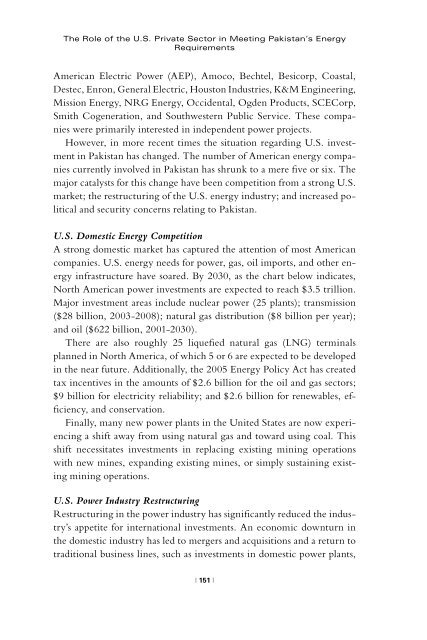fueling the future - Woodrow Wilson International Center for Scholars
fueling the future - Woodrow Wilson International Center for Scholars
fueling the future - Woodrow Wilson International Center for Scholars
- No tags were found...
Create successful ePaper yourself
Turn your PDF publications into a flip-book with our unique Google optimized e-Paper software.
The Role of <strong>the</strong> U.S. Private Sector in Meeting Pakistan’s EnergyRequirementsAmerican Electric Power (AEP), Amoco, Bechtel, Besicorp, Coastal,Destec, Enron, General Electric, Houston Industries, K&M Engineering,Mission Energy, NRG Energy, Occidental, Ogden Products, SCECorp,Smith Cogeneration, and Southwestern Public Service. These companieswere primarily interested in independent power projects.However, in more recent times <strong>the</strong> situation regarding U.S. investmentin Pakistan has changed. The number of American energy companiescurrently involved in Pakistan has shrunk to a mere five or six. Themajor catalysts <strong>for</strong> this change have been competition from a strong U.S.market; <strong>the</strong> restructuring of <strong>the</strong> U.S. energy industry; and increased politicaland security concerns relating to Pakistan.U.S. Domestic Energy CompetitionA strong domestic market has captured <strong>the</strong> attention of most Americancompanies. U.S. energy needs <strong>for</strong> power, gas, oil imports, and o<strong>the</strong>r energyinfrastructure have soared. By 2030, as <strong>the</strong> chart below indicates,North American power investments are expected to reach $3.5 trillion.Major investment areas include nuclear power (25 plants); transmission($28 billion, 2003-2008); natural gas distribution ($8 billion per year);and oil ($622 billion, 2001-2030).There are also roughly 25 liquefied natural gas (LNG) terminalsplanned in North America, of which 5 or 6 are expected to be developedin <strong>the</strong> near <strong>future</strong>. Additionally, <strong>the</strong> 2005 Energy Policy Act has createdtax incentives in <strong>the</strong> amounts of $2.6 billion <strong>for</strong> <strong>the</strong> oil and gas sectors;$9 billion <strong>for</strong> electricity reliability; and $2.6 billion <strong>for</strong> renewables, efficiency,and conservation.Finally, many new power plants in <strong>the</strong> United States are now experiencinga shift away from using natural gas and toward using coal. Thisshift necessitates investments in replacing existing mining operationswith new mines, expanding existing mines, or simply sustaining existingmining operations.U.S. Power Industry RestructuringRestructuring in <strong>the</strong> power industry has significantly reduced <strong>the</strong> industry’sappetite <strong>for</strong> international investments. An economic downturn in<strong>the</strong> domestic industry has led to mergers and acquisitions and a return totraditional business lines, such as investments in domestic power plants,| 151 |
















